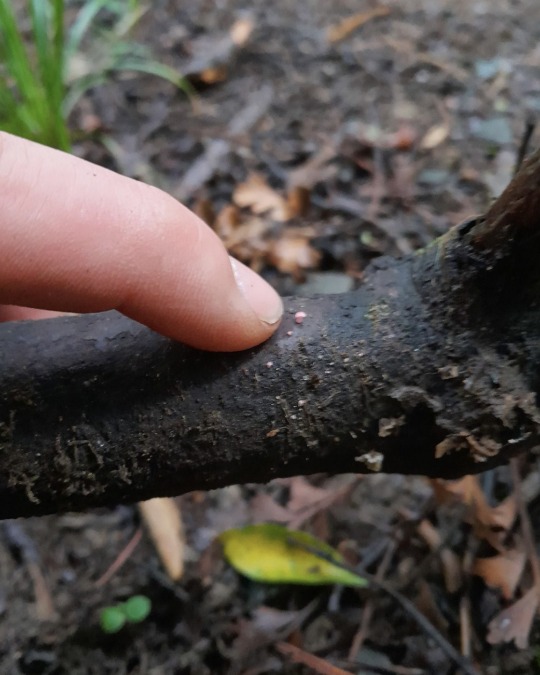#Joseph Pallante
Explore tagged Tumblr posts
Text


Tubifera microsperma by myconeer
#joseph pallante#myconeer#myxomycota#tubifera#tubifera microsperma#slime mold#slime moulds#forest floor#nature#forest#protists#protozoa#clusters#trypophobia#slime mould#macro photography#biology#mycology#myxomycology#texture
319 notes
·
View notes
Text
~ 0Oooo0o0O0OOoOOo0o00o0o00 ~ ! ~ It Glows ~ ! ~

Joseph Pallante, CC BY-SA 4.0 https://creativecommons.org/licenses/by-sa/4.0, via Wiki



Super tiny Mycena Roseoflava.
Photographed by cyanesense
#Joseph Pallante#Mycena roseoflava#greta stevenson#women in STEM#mycologist#Mycenaceae#Agaricales#Agaricomycetes#Basidiomycota#basidiocarps#<- this is fungus familiy that contains ->#mushrooms#fungi#nature photography#new zealand#aotearoa#hollowinthegrotto#photo#mollybeenoel#mycellium#photography#small shroom#cute#pink#pretty#mycology#bioluminescence#small#tiny#fave
50K notes
·
View notes
Text


Unidentified Pink Mycena 🎟️
By Joseph Pallante (myconeer) on instagram
#nature#fungi#mushrooms#mycology#cottagecore#plants#aesthetic#nature aesthetic#plant aesthetic#mushroom aesthetic#cottagecore aesthetic#mycena
361 notes
·
View notes
Text

Coloured Still Life, 1967
Patrick Joseph Caulfield, CBE, RA (29 January 1936 – 29 September 2005), English painter and printmaker
Acrylic on board
Pallant House Gallery
#english imagination#english culture#albion#england#art#english art#english artist#english landscape#patrick caulfield#still life#modern art#1960s art#1960s
0 notes
Text
2024 St. Louis Cardinals Players By Nationality
American: 29 (Nolan Arenado, Alec Burleson, Dylan Carlson, Matt Carpenter, Brandon Crawford, Brendan Donovan, Tommy Edman, Ryan Fernandez, Kyle Gibson, Paul Goldschmidt, Nolan Gorman, Sonny Gray, Ryan Helsley, Andrew Kittredge, Matthew Liberatore, Michael Lynn, Steven Matz, Keynan Middleton, Miles Mikolas, Lars Nootbaar, Riley O'Brien, Andre Pallante, Drew Rom, Joseph Romero, Victor Scott; Jr., Michael Siani, Zach Thompson, Jordan Walker & Masyn Winn) Mexican: 1 (Giovanny Gallegos) Panamanian: 1 (Iván Herrera) Venezuelan: 1 (Willson Contreras)
0 notes
Text
welcome to “assigning (tfp) transformers mushrooms”! this is a rather long post, so i'll be putting it under a readmore. this is only the decepticons, since i hit photo limit—i'll reblog with all the autobots in a few minutes, so you might want to wait for that
soundwave: indigo pinkgill. such an elegant, dignified species! with a cap surface ranging from smooth to finely scaled, this unassuming, indigo-blue to almost black mushroom native to most of eurasia is a perfect fit for the unassuming, but possibly deadly, decepticon communications officer and spymaster!

(indigo pinkgill by peter creed)
starscream: what better fit for the ambitious, vibrant decepticon SIC than the scaly tangerine mushroom? a species first noted in zanzibar, its fruiting bodies are rather small in comparison to other species, but what they lack in size, they make up for in lustrous gold colouring, with almost-spiny protrusions from their caps.

(scaly tangerine mushroom by ShaumingLo on project noah)
knock out: what better fungi to fit this flashy red mech with a not-so-secret lethality than russula emetica? known colloquially as “the sickener”, this species is poisonous in its natural form, but, despite this, was often eaten in eastern europe after boiling to remove its toxins. while both it and the decepticon medic may be grudgingly tolerated, they form an important part of the woodland ecosystems of eurasia, and northern africa and america.

(russula emetica by MichalPL on wikipedia)
arachnid: rosy larch bolete. mainly found on larches in the western region of north america, these alluring, dusky pink mushrooms also have been reported to live on pines in china and taiwan. while the fruiting bodies may appear delicate and tempting, they’re said to be incredibly bitter.

(rosy larch bolete by debbie viess)
shockwave: this mystifying and slightly intimidating mech could be none other than the oak bracket! while this species initially grows at the bases of living trees, its presence is often fatal to them. when found on urban and garden trees, it often leads to preventative felling. however, they’re also said to have antibiotic properties!

(oak bracket by juniors bildarchiv gmbh/alamy stock photo)
breakdown: what could fit better for this solid, determined mech than the apple tooth? while originally fairly common and found on old apple trees in orchards, the felling of so many of these orchards has made it increasingly rare, even becoming a part of the red list of endangered fungal species in some countries. its simplistic shape, formed of thousands of what appear to be fungal stalactites crowded together, nonetheless is incredibly breathtaking once given a second glance.

(apple tooth fungus by lucie zíbarová)
dreadwing: for an honourable and surprisingly elegant mech, what could fit better than hericium coralloides? this beautiful, frost-like mushroom is prized in many asian countries, where it can be found gift-wrapped in flamboyant packages.

(hericium coralloides by michael wood)
megatron: violet potato fungus. the simplistic form of this mushroom reminds one of megatron’s early days as a miner. however, like the mech himself, it has surprising traits as well—a striking purple, the insides of its truffle-like fruiting bodies are a rich, olive- to dark greyish-brown.

(violet potato fungus by joseph pallante on inaturalist)
(all information taken from the book of fungi by peter roberts and shelley evans)
27 notes
·
View notes
Text
Musk backtracks on Bitcoin, Binance under investigation? — Is the bull run over?

youtube
Elon Musk announced Tesla won’t accept any further payments in Bitcoin, citing energy consumption concerns. Rumors are circulating that Binance is under investigation from the IRS and Justice Department. Bitcoin and Ethereum are down more than 12% in the last 24 hours. Is this end of the bull run?
Guests: Scott Melker, trader at Wolf of all Streets (@scottmelker) Mike McGlone, Bitcoin strategist at Bloomberg (@mikemcglone11) Marcel Pechman, market analyst at Cointelegraph (@RadarBtc) Joseph Pallant, founder at Blockchain for Climate Foundation (@josephpallant)
Subscribe to Cointelegraph Markets Pro: https://pro.cointelegraph.com
#Cointelegraph #Bitcoin #CryptoMarkets
Subscribe to Cointelegraph: https://goo.gl/JhmfdU
Follow COINTELEGRAPH: Website: https://cointelegraph.com/ Telegram: https://t.me/cointelegraph Facebook: https://www.facebook.com/cointelegraph Twitter: https://twitter.com/cointelegraph
Cointelegraph covers everything Bitcoin, bringing you the latest news, prices, breakthroughs, and analysis, with emphasis on expert opinion and commentary from the digital currency community.
The post Musk backtracks on Bitcoin, Binance under investigation? — Is the bull run over? appeared first on BLOCKPATHS.
source https://blockpaths.com/news/musk-backtracks-on-bitcoin-binance-under-investigation-is-the-bull-run-over/
0 notes
Text
Experts debate Bitcoin climate footprint in latest Cointelegraph Crypto Duel
Experts debate Bitcoin climate footprint in latest Cointelegraph Crypto Duel
In the latest Cointelegraph Crypto Duel, founder of Digiconomist Alex de Vries and CEO and founder of Blockchain for Climate Joseph Pallant debated the intensity of Bitcoin’s footprint and possible paths forward to reduce it. As pointed out by de Vries, Bitcoin’s energy consumption has been increasing together with its network. The analyst predicts its carbon footprint could increase…

View On WordPress
0 notes
Text
Experts debate Bitcoin climate footprint in latest Cointelegraph Crypto Duel
Experts debate Bitcoin climate footprint in latest Cointelegraph Crypto Duel
In the latest Cointelegraph video debate, experts discuss pathways towards making Bitcoin more sustainable. In the latest Cointelegraph Crypto Duel, founder of Digiconomist Alex de Vries and CEO and founder of Blockchain for Climate Joseph Pallant debated the intensity of Bitcoin’s footprint and possible paths forward to reduce it. As pointed out by de Vries, Bitcoin’s energy consumption has…

View On WordPress
0 notes
Text
Experts debate Bitcoin climate footprint in latest Cointelegraph Crypto Duel
Experts debate Bitcoin climate footprint in latest Cointelegraph Crypto Duel
In the latest Cointelegraph Crypto Duel, founder of Digiconomist Alex de Vries and CEO and founder of Blockchain for Climate Joseph Pallant debated the intensity of Bitcoin’s footprint and possible paths forward to reduce it. As pointed out by de Vries, Bitcoin’s energy consumption has been increasing together with its network. The analyst predicts its carbon footprint could increase…

View On WordPress
0 notes
Text

Hemitrichia serpula by Joseph Pallante
#hemitrichia serpula#pretzel slime mold#joseph pallante#myconeer#myxomycota#slime mold#slime mould#macro photography#forest floor#texture#trypo
112 notes
·
View notes
Link
In Coinbase’s Rise, a Reminder: Cryptocurrencies Use Lots of Energy The stock market debut of Coinbase, a start-up that allows people to buy and sell cryptocurrencies like Bitcoin, is a watershed moment for digital money. It also threatens to lock in a technology with an astonishing environmental footprint. Cryptocurrencies use blockchain technology, which relies on specialized computers racing to solve complex equations, making quintillions of attempts a second to verify transactions. It’s that practice, called “cryptomining,” that makes the currencies so energy-intensive. Researchers at Cambridge University estimate that mining Bitcoin, the most popular blockchain-based currency, uses more electricity than entire countries like Argentina do. “All this accounts for so little of the world’s total transactions, yet has the carbon footprint of entire countries. So imagine it taking off — it’ll ruin the planet,” said Camilo Mora, a climate scientist at the University of Hawaii at Manoa. Dr. Mora argued in a controversial 2018 paper that Bitcoin emissions alone could push global warming above the Paris Agreement target of 2°C, a level beyond which scientists warn the world will experience ever-more-catastrophic effects of climate change. (Some of the paper’s assumptions have since been called out as implausible.) Still, cryptocurrencies’ heavy environmental toll is starting to roil climate policy. In a new paper published this month, researchers warned that, if left unchecked, Bitcoin mining in China — where an estimated two-thirds of the world’s blockchain mining takes place — could make it difficult for the world’s largest polluter to meet its climate goals. China’s Inner Mongolia region said recently that it was moving to ban the practice, because it was hampering the province’s efforts to meet the new carbon-emissions goals set by the national government. Iran has also cracked down on Bitcoin mining, calling it a burden on its electric grid, after blackouts hit Tehran and other major cities earlier this year. Hand-wringing over cryptomining has even reached the art world, where some artists have taken a stand over NFTs — pieces of digital artwork stamped with a unique string of code and stored blockchains — for their outsized environmental impact. On Wednesday, shares in Coinbase, the first major cryptocurrency company to list its shares on a stock exchange in the United States, immediately soared, pushing its valuation close to $100 billion, in what was hailed by investors as a landmark moment for the growth of digital currencies. Coinbase, on its website, calls the notion that Bitcoin is bad for the environment a “myth.” It points to finance-industry research that calls the digital currency’s energy consumption trivial compared to traditional banking. But though their use is surging, cryptocurrencies still account for just a fraction of global transactions. Alex de Vries, who keeps track of the use on the site Digiconomist, estimates that each Bitcoin transaction requires tens of thousands of times more electricity to process than each Visa credit card transaction, for example. Bitcoin mining’s heavy energy usage owes in large part to its reliance on what’s called “proof of work” — a computing method that’s intentionally designed to be inefficient to keep currencies transparent and decentralized. Proof of work forces miners to compete to solve cryptographic puzzles in an intense race of trial and error, their computers together making more than 160 quintillion attempts a second to produce a new block. This competition keeps immense numbers of computers working at top speed, around the clock and all over the world. “The mechanism of proof of work is kind of counterintuitive,” said Susanne Köhler, a researcher at Aalborg University in Denmark who has carried out life-cycle analysis of blockchain technology. “While the machines are getting more efficient, the network does not reduce energy consumption,” because an ever-growing number of miners must compete, making an ever-growing number of guesses. There are efforts afoot to make blockchain technologies more environmentally sustainable — and to put them to use in climate policy. The nonprofit group Blockchain for Climate, for example, has led the way in developing ways to use blockchain for carbon trading — in other words, systems that allow one country, or company, to pay and take credit for carbon-emissions reductions in another country or company. And then there is a transition to a “proof of stake” method, which doesn’t force miners to compete to add blocks to the blockchain, and instead awards miners new blocks based on how much cryptocurrency they already own. The world’s second-largest cryptocurrency by market capitalization, Ethererum, has said it is moving toward proof of stake (that switch is likely to take up to another year), and Bitcoin is expected to eventually follow. “That reduces your emissions to almost nothing,” said Joseph Pallant, Blockchain for Climate’s founder and executive director. Cryptocurrency platforms like Tezos or Near Protocol already use proof of stake and have vastly lowered their energy use. And for individual Bitcoin users, reducing your impact through carbon offsets is another way forward, he said. “Rather than just be like, ‘Ah, I’m going to back away and not touch it,’ I’d say dive in and then figure out what you need to do for your conscience,” Mr. Pallant said. Source link Orbem News #Coinbases #Cryptocurrencies #Energy #Lots #reminder #Rise
0 notes
Text
Blockchain Is Paving the Way Towards Reduced Carbon Emissions
Debate continues to rage about the best practices and strategies needed to collectively curb carbon emissions. Blockchain tech can help.
As cryptocurrencies grow in popularity, so does the debate about their energy usage.
Research has purported energy consumption habits by miners could be leading to carbon emission levels that could be interfering with national climate change mitigation obligations.
Others figures like Stanford’s Jonathan Koomey note that there is not enough research and data available to be certain about the amount of power mining eats up.
Despite the debate about energy consumption and emissions, many see blockchain as a way to open up traditionally centralized carbon markets to a wider variety of players — eventually accelerating the shift towards a low carbon worldwide economy.
Fighting Pollution With Blockchain
A bulk of today’s work related to climate change and carbon output focuses on crafting legislative agreements and compliance mechanisms to slash emissions and lend support to sustainability and efficiency projects.
The United Nations announced the Climate Change Coalition (CCC) in January, which is designed to study and research how blockchain can help combat climate change.
Members in the CCC will look into distributed ledger technologies and carry out pilot projects to test out use cases.
Otherwise, a large amount of debate and discussion inside of the UN has revolved around the Paris Agreement, which has come under heavy criticism in recent months.
Some startups, like the Blockchain for Climate Foundation (BFC) in Canada, are looking to use blockchain to build a tool that could achieve one of the big objectives spelled out in the agreement.
Article 6.2 proposes the idea of a unit carbon impact transfer value, referred to as Internationally Transferred Mitigation Outcomes (IMTOs). The eventual outcome would the crafting of a system that links every nation’s carbon accounts together.
BFC founder Joseph Pallant says his team’s goal is to, “support and accelerate this goal,” by using Ethereum to track IMTOs via smart contracts.
He says there would be enough data inside of each token so everyone is clear about the “provenance and eligibility of each tonne of emissions reduction.” BFC has also come up with a draft for “Unique Fungible Tokens” which allow the authenticity of carbon credits to be validated.
Moving To A Low Carbon Economy
A handful of companies, like Veridium, have been exploring the idea of tokenizing carbon offset credits. The firm teamed up with IBM to carry out this effort with the Stellar blockchain.
Buying traditional carbon credits is often a lengthy process, but Veridium Foundation executive director Jim Procanik thinks blockchain is the “perfect background” towards a more liquid marketplace.
Another company called Poseidon is also using Stellar to lower entry barriers into the carbon credit market.
Poseidon recently teamed up with Ben & Jerry’s to cut carbon credits into microtransactions, so ice cream connoisseurs in London can offset their carbon emissions in real time. The project has reportedly protected more than 4,000 trees so far.
What do you think blockchain’s role in combating climate change ought to be? Let us know in the comments below!
Images courtesy of Bitcoinist archives, Shutterstock.
The post Blockchain Is Paving the Way Towards Reduced Carbon Emissions appeared first on Bitcoinist.com.
from Cryptocracken Tumblr https://ift.tt/2OGkQ5L via IFTTT
0 notes
Link
A play about William Wordsworth where stars John Sackville was played in the Theatre By The Lake in Keswick in the UK.
0 notes
Text
2024 St. Louis Cardinals Roster
Pitchers
#27 Andrew Kittredge (Spokane, Washington)*
#31 Michael Lynn (Brownsburg, Indiana)*
#32 Steven Matz (Brookhaven, New York)
#38 Drew Rom (Ft. Thomas, Kentucky)
#39 Miles Mikolas (Jupiter, Florida)
#44 Kyle Gibson (Greenfield, Indiana)*
#52 Matthew Liberatore (Glendale, Arizona)
#53 Neil Pallante (San Clemente, California)
#54 Sonny Gray (Smyrna, Tennessee)*
#55 Riley O'Brien (Shoreline, Washington)*
#56 Ryan Helsley (Tahlequah, Oklahoma)
#57 Zach Thompson (Selma, Indiana)
#59 Joseph Romero (Oxnard, California)
#64 Ryan Fernandez (Tampa, Florida)**
#65 Giovanny Gallegos (Ciudad Obregón, Mexico)
#93 Keynan Middleton (Milwaukie, Oregon)*
Catchers
#40 Willson Contreras (Puerto Cabello, Venezuela)
#48 Iván Herrera (Ciudad Panama, Panama)
Infielders
#6 Masyn Winn (Houston, Texas)
#13 Matt Carpenter (Sugar Land, Texas)*
#16 Nolan Gorman (Phoenix, Arizona)
#19 Tommy Edman (San Diego, California)
#28 Nolan Arenado (Lake Forest, California)
#35 Brandon Crawford (Pleasanton, California)*
#46 Paul Goldschmidt (Houston, Texas)
Outfielders
#3 Dylan Carlson (Elk Grove, California)
#11 Victor Scott; Jr. (Power Springs, Georgia)**
#18 Jordan Walker (Decatur, Georgia)
#21 Lars Nootbaar (El Segundo, California)
#33 Brendan Donovan (Enterprise, Alabama)
#41 Alec Burleson (Lincoln County, North Carolina)
#63 Michael Siani (Cheltenham Township, Pennsylvania)
Coaches
Manager Oliver Marmol (Orlando, Florida)
Bench coach Daniel Descalso (Mountain View, California)
Hitting coach Brandon Allen (Conroe, Texas)
Assistant hitting coach Turner Ward (Orlando, Florida)
Pitching coach Dusty Blake (Candor, North Carolina)
Assistant pitching coach Dean Kiekhefer (Oldham County, Kentucky)
Assistant pitching coach Julio Rangel (Ciudad Panama, Panama)
Bullpen coach Jamie Pogue (Guelph, Ontario)
Bullpen catcher Kleininger Teran (Maracay, Venezuela)
1B coach Richard Clapp (Windsor, Ontario)
3B coach Ron Warner (Alhambra, California)
Assistant coach Patrick Elkins (Raleigh, North Carolina)
Assistant coach Willie McGee (Richmond, California)
#Sports#Baseball#MLB#St. Louis Cardinals#Celebrities#Indiana#Tennessee#New York#Florida#Mexico#Washington#Arizona#Oklahoma#Oregon#Kentucky#Venezuela#Panama#Texas#North Carolina#Alabama#Georgia#Pennsylvania#Canada#Ontario
0 notes
Text
Bitcoin Climate Debate: Overblown FUD or genuine threat? | Cointelegraph Crypto Duel

youtube
Alex de Vries, founder of Digiconomist, and Joseph Pallant, CEO and founder of Blockchain for Climate, debate Bitcoin’s energy consumption, its impact on the environment and possible solutions.
0:00 Intro 1:14 Is Bitcoin’s environmental impact exaggerated? 5:05 Can Bitcoin be compared to Visa in terms of carbon emissions? 8:04 Are Bitcoin miners incentivized to use renewable energy? 12:28 Is Ethereum’s switch to proof-of-work a viable solution for reducing carbon emissions? 15:19 How can Bitcoin become more climate-friendly? 20:37 Outro
Subscribe to Cointelegraph Markets Pro: https://pro.cointelegraph.com
#Cointelegraph #Bitcoin #CryptoMarkets
Subscribe to Cointelegraph: https://goo.gl/JhmfdU
Follow COINTELEGRAPH: Website: https://cointelegraph.com/ Telegram: https://t.me/cointelegraph Facebook: https://www.facebook.com/cointelegraph Twitter: https://twitter.com/cointelegraph
Cointelegraph covers everything Bitcoin, bringing you the latest news, prices, breakthroughs, and analysis, with emphasis on expert opinion and commentary from the digital currency community.
The post Bitcoin Climate Debate: Overblown FUD or genuine threat? | Cointelegraph Crypto Duel appeared first on BLOCKPATHS.
source https://blockpaths.com/news/bitcoin-climate-debate-overblown-fud-or-genuine-threat-cointelegraph-crypto-duel/
0 notes